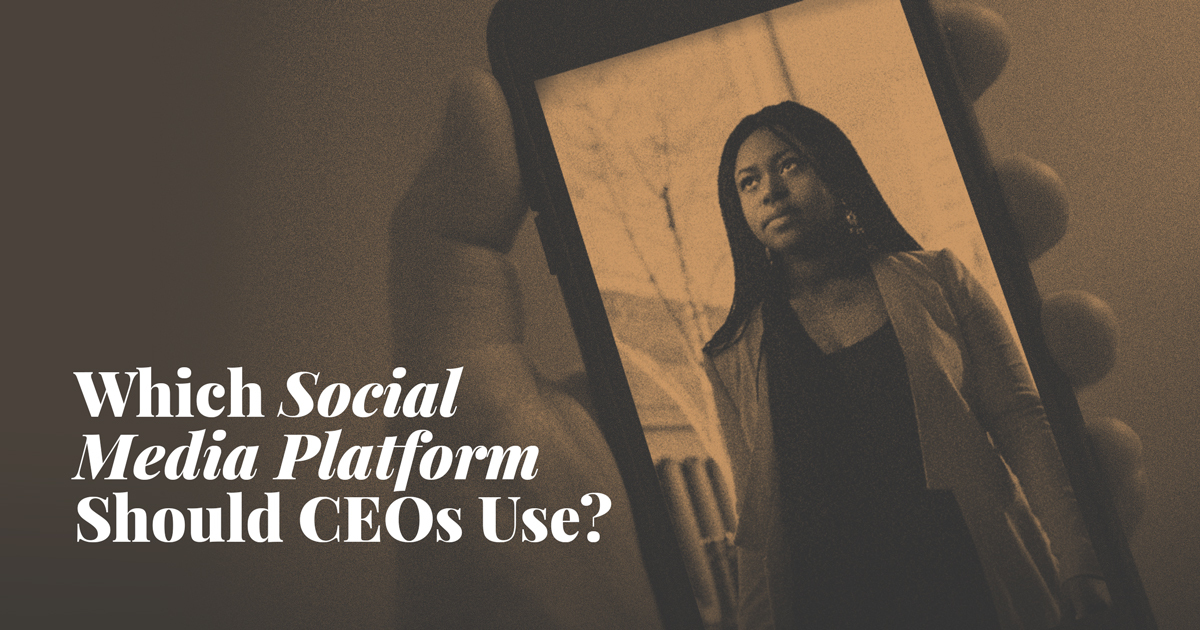In our recent series about the top retail executives you should be following on social media, we looked at ways they use online platforms to help build their personal brand while achieving their business objectives. Establishing a brand presence on social media is second nature to most digital marketers, but what about helping their company’s executives establish their own profile? One of the first steps is understanding which social media platform would be the best fit for your executives.
In this article, we look at some of the most popular social media platforms and what makes them stand out. By the end of this article, marketers should have a clearer picture of which social media platforms to position their executives on.
Before we get started, don’t forget to download our free step-by-step guide on how to get your company’s executives on social media.
Which social media platform should executives use?
-
Use LinkedIn to build professional connections
-
Use Twitter to share relevant bite-sized content
-
Use Instagram to create media that captivates
-
Use Facebook to reach a large audience
Executives should use LinkedIn if:
- They want a social media profile that doubles as a resume
- They’re interested in sharing long-form content
- They’re looking to establish a strong presence for their B2B company
After analyzing the Fortune 500 list, we found that 94% of CEOs were on LinkedIn. What makes it such an appealing platform for executives?
Well, LinkedIn is a business-oriented platform that’s built for making connections in your industry, it’s a hotspot for many B2B marketers, and it’s an effective platform for executives to establish their thought leadership. While many social media platforms like Twitter and TikTok prioritize short, bite-sized content, LinkedIn’s Article section allows executives to share long-form content that can better help build their professional credibility within their industry.
Now is also an excellent time for executives to start using LinkedIn since many exciting new features have been added this year. New additions—such as stories, live videos, and polls—have added another layer of interactivity to LinkedIn content.
One executive who has built an effective LinkedIn presence is Daniel Lubetzky, the founder of KIND.
Executives should use Twitter if:
- They don’t have time to create a lot of content
- They want to be more personally involved in sharing articles or their own thoughts
- They want a simpler social media platform
Compared to some of the other social media platforms on this list, Twitter is one of the easiest apps to use. Part of this stems from its much lower 280 character limit on its tweets, which means not all content types will be suitable for this platform. Posts on Twitter are short and to the point, but that doesn’t mean it can’t be used strategically by executives. Compared to other social media platforms that have added a variety of new features, Twitter has remained rather stable in terms of its core offerings: tweets and in-feed video (compare this to Instagram’s in-feed posts/videos, IGTV, Reels, Shops, and so on).
Since many people use Twitter as their primary social media platform to stay updated, this is an effective platform for executives to share company announcements and other news.
Mary Barra, the CEO of General Motors, is an example of an executive with a strong Twitter presence.
We have reached an important inflection point at @GM. We are transitioning to an all-electric portfolio, and doing so from a position of unprecedented strength. This is how we will win. pic.twitter.com/9HeJlntI9v
— Mary Barra (@mtbarra) November 23, 2020
Executives should use Instagram if:
- They have the capacity to generate enough visual content (e.g. images, videos) and don’t intend to share a lot of links (i.e. to articles or the company website)
- They want to appear more personable and approachable
- They’re tech-savvy and don’t mind learning about best practices on social media
Instagram stands out as being a platform driven by visual (rather than written) content. Posts must be accompanied by an image or video, unlike other platforms where you can share a text-only post. Because of the visual nature of Instagram, this is a great platform for executives in B2C industries, such as fashion or other consumer goods. Most executives’ Instagram content revolves around visual content, of which they are often the primary subject highlighted in the image or video. Because of this, Instagram content feels much more personal, as opposed to professional, to a user.
Because Instagram is constantly updating and adding new features to its app, this platform is a good fit for executives who want to stay ahead of social media trends and are willing to learn about different social media features. Knowing best practices and what a Reel is versus an IGTV video can help guide content creation to make it more strategic and business-oriented.
An example of an executive making effective use of Instagram is Tory Burch, founder of Tory Burch LLC.
Executives should use Facebook if:
- Their company has an older audience or they want to target a wide range of demographics
- They’re also on Instagram and want the convenience of cross-posting content
- They want to supplement their brand’s presence
Facebook saw over 2.7 billion monthly users in 2020, making it one of the most popular social media apps. While this platform’s user base has a very wide demographic, this platform also attracts more older users compared to other social media apps. This makes it particularly appealing for certain brands who are looking to reach a diverse audience or an older one.
Facebook, Inc. (the company) also owns several other social media platforms, including Instagram. Since buying Instagram, Facebook has added a number of features that help users cross-post to both platforms from one app. In other words, if an executive is posting an image on Instagram, they’ll also have the ability to share it directly to their connected Facebook account.
An executive who’s making effective use of Facebook is Doug McMillon, the CEO of Walmart.
Which social media platform is right for your brand’s CEO?
Choosing the right platform provides a strong foundation for a CEO’s online presence. Aligning business goals and content creation with the right social media platform is an effective way to reach your brand’s audience and deliver content that’s accessible and relevant to them.
While each of the social media platforms mentioned above have their own benefits, consider how a multi-platform approach can help maximize an executive’s reach in order to achieve business objectives. For marketers and executives who want to learn more about establishing a strategic executive social media marketing program, click the button below to talk to one of our executive marketing experts.
href="#" data-color-override="false" data-hover-color-override="false" data-hover-text-color-override="#fff">Develop a strong executive social media program today!


